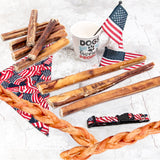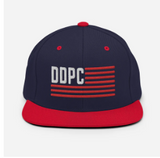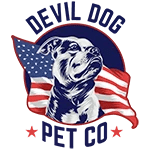Yes, bully sticks are safe for most dogs when properly supervised. As 100% beef muscle treats that are fully digestible, they're a significantly safer alternative to rawhide, antlers, or household items your pup might otherwise target.
During my years in the Marines, I learned that proper equipment can make or break a mission—the same applies to your dog's chew arsenal. Our dog Dexter taught us this lesson repeatedly before we launched Devil Dog Pet Co., destroying everything from boot laces to furniture until we found the right chews to redirect his powerful jaws.
Key Takeaways
- Bully sticks are safe for most dogs when given under proper supervision.
- They are made from 100% beef muscle and are fully digestible.
- Bully sticks are a safer alternative to rawhide, antlers, or household items dogs might chew on.
- Choosing the right chew treats can prevent damage to household items and redirect a dog's chewing behavior.
- Experience with dogs, like Dexter, highlights the importance of selecting appropriate chews for strong jaws.
Table of Contents
- What Are Bully Sticks?
- Are Bully Sticks Safe for Dogs?
- Safety Considerations: How to Use Bully Sticks Properly
- Can Puppies Have Bully Sticks?
- Potential Risks: When Bully Sticks Might Not Be Ideal
- How Often Can Dogs Have Bully Sticks?
- Bully Sticks vs. Other Chew Options
- Common Concerns About Bully Sticks: Fact vs. Fiction
- How to Choose High-Quality Bully Sticks
- Maximizing Bully Stick Benefits: Pro Tips
- Advanced Training Uses for Bully Sticks
- Bully Sticks for Special Needs Dogs
- The Ethical Dimension: Sustainability and Sourcing
- Conclusion: Are Bully Sticks Safe for Dogs?
That said, no chew is universally "safe" without owner leadership. You need to match the stick to your dog's size, supervise every session, and retire the chew once it becomes small enough to swallow. Let's break down exactly what makes these protein-packed powerhouses a staple in responsible dog households.
What Are Bully Sticks?
Before we dive into safety, let's establish what you're actually handing your four-legged battle buddy.
Definition and Origin
Bully sticks are single-ingredient dog chews made from 100% beef pizzle (bull penis). That's right—the anatomical reality might make some owners squeamish, but your dog couldn't care less about the origin story. They only know it's packed with flavor, scent, and satisfying texture.
These chews undergo a thorough cleaning process, then are stretched, dried, and slow-baked to create the firm, fibrous sticks that dogs find irresistible. The result is a high-protein, low-fat treat that's fully digestible—unlike rawhide, which can sit in a dog's system for days or cause blockages.
Types and Forms
Bully sticks come in several configurations to match different chewing styles:
- Standard straight sticks – Single strands ideal for moderate chewers
- Jumbo (ultra thick) sticks – Built for power-chewers who demolish standard options (see extra thick bully sticks)
- Braided sticks – Three strands woven together for extended chew time
- Rings, springs, and shapes – Novelty forms that can slow down aggressive chewers
Length varies too, typically from 4 to 12 inches. The right size depends on your dog's weight, jaw strength, and chewing habits—not just breed. I've seen 15-pound terriers outchew 80-pound retrievers.
Are Bully Sticks Safe for Dogs?
 are bully sticks good for dogs teeth">
are bully sticks good for dogs teeth">
When used correctly, bully sticks rank among the safest chew options available. Here's why they beat the competition on safety:
Digestibility Factor
Unlike rawhide or plastic toys, bully sticks are 100% digestible. This means that if your dog swallows a small piece, it will break down naturally in their digestive system rather than forming a dangerous blockage. The digestibility factor alone puts bully sticks leagues ahead of many popular alternatives. For a deeper dive into the science and veterinary perspective, see this veterinary resource on chew treat safety.
When our dog Dexter was younger, he once managed to gulp down the end of a bully stick when I looked away for literally five seconds. While I panicked initially, our vet assured me that unlike rawhide—which can swell and cause intestinal blockages—the bully stick would digest normally. And it did, without incident.
Dental Benefits
The fibrous texture of bully sticks creates a natural flossing action as your dog chews. This mechanical scraping helps reduce plaque and tartar buildup, supporting dental health between brushings. The extended chewing time also increases saliva production, which helps neutralize mouth acids that contribute to dental disease.
However, this doesn't replace proper dental care—think of bully sticks as supplemental support, not a replacement for brushing or professional cleanings. For more tips, check out our guide to the best dental chews for dogs.
Mental Enrichment
A bored dog is a destructive dog. Providing appropriate outlets for natural chewing instincts prevents your pup from redirecting to furniture, shoes, or worse—electrical cords. The sustained focus required to work through a quality bully stick delivers mental stimulation and releases endorphins, creating a calming effect that can reduce anxiety and destructive behaviors.
This mental exercise is just as important as physical exercise for many dogs. A 20-minute session with a bully stick can tire out a dog's brain similarly to a training session.
Safety Considerations: How to Use Bully Sticks Properly
Even the safest products require proper handling. Here's how to maximize safety when offering bully sticks:
Supervision is Non-Negotiable
Never leave your dog alone with a bully stick. Period. This isn't helicopter parenting—it's Extreme Dog Leadership. Dogs who chew unsupervised can break off large chunks and attempt to swallow them, creating choking hazards. Stay within sight and be ready to intervene.
In the Marines, we never left a post unattended. Apply the same discipline to chew time. If you can't watch, the chew gets put away until you can.
Choking Prevention
The most significant safety risk with bully sticks isn't the material itself—it's the potential choking hazard when a dog gets down to the last couple of inches. Once the stick becomes short enough to fit entirely in your dog's mouth, it's time to take it away.
Pro tip: Use a bully stick holder that secures the end of the stick, preventing your dog from swallowing the last piece. Alternatively, trade the nub for a fresh treat before it becomes a hazard.
Size Matters
Match the bully stick size to your dog's chewing style and jaw strength:
- Small dogs (under 25 lbs): Standard 6-inch sticks
- Medium dogs (25-50 lbs): Standard or jumbo 6-inch sticks
- Large dogs (50+ lbs): Jumbo 12-inch sticks or braided options
- Power chewers of any size: Always go jumbo or braided
Remember: Sizing up is always safer than sizing down. A stick that's too small creates a greater choking risk. If you're unsure about sizing, our post on how to choose safe dog chews for your dog is a helpful resource.
Quality Sourcing
Not all bully sticks are created equal. Low-quality options may contain chemicals, preservatives, or come from questionable sources. Look for:
- Single-ingredient product listings (100% beef)
- Sticks from free-range, grass-fed cattle when possible
- No added colors, flavors, or preservatives
- USDA-approved facilities for processing
Quality matters for both safety and longevity. Premium bully sticks from reputable sources like Devil Dog Pet Co. undergo rigorous cleaning processes and quality control checks.
Can Puppies Have Bully Sticks?

Yes, bully sticks are generally safe for puppies once they have their adult teeth, typically around 5-6 months of age. However, there are important considerations:
Puppy-Specific Guidelines
For puppies, follow these additional safety measures:
- Start with shorter, supervised sessions (10-15 minutes max)
- Choose standard thickness sticks initially, even for breeds that will grow large
- Monitor closely for aggressive chewing styles that might damage developing teeth
- Be extra vigilant about removing the last few inches
Puppies are still developing chewing habits and jaw strength. Introducing appropriate chews early helps establish good habits and redirects teething urges away from your furniture and hands.
Introducing Bully Sticks
When offering a bully stick to your puppy for the first time:
- Hold one end while they explore the other end
- Praise calm chewing behavior
- Remove the stick if they try to gulp or swallow large pieces
- Store the stick between sessions rather than leaving it available all day
This controlled introduction sets boundaries and teaches appropriate chewing from the start—a cornerstone of Extreme Dog Leadership.
Potential Risks: When Bully Sticks Might Not Be Ideal
While generally safe, bully sticks aren't perfect for every dog in every situation:
Digestive Sensitivity
Some dogs experience digestive upset when first introduced to bully sticks. The rich protein content can cause loose stools or even diarrhea if consumed too quickly or in large amounts. This is particularly common when:
- The dog has a sensitive stomach
- Too much of the stick is consumed in one sitting
- The dog isn't accustomed to high-protein treats
Start with short sessions and monitor your dog's reaction. If digestive issues occur, reduce frequency or serving size before trying again. For additional scientific perspective, you can read this Tufts veterinary overview on bully stick risks.
Caloric Content
Bully sticks are nutrient-dense. A standard 6-inch stick contains approximately 80-90 calories, while jumbo or 12-inch versions can exceed 200 calories. For perspective, that could represent up to 25% of a small dog's daily caloric needs.
If your dog enjoys daily bully sticks, adjust their regular meals accordingly to prevent weight gain. Remember the 10% rule: treats should comprise no more than 10% of your dog's daily caloric intake.
Aggressive Chewers
Dogs that attack chews with excessive force may risk dental damage. If your dog tries to crack or split the stick rather than gnaw gradually, you might need to explore other options or limit sessions to prevent tooth fractures.
When our dog Dexter was younger, he'd try to snap bully sticks in half immediately. We had to teach him to chew more gradually by holding one end and only allowing side-chewing until he developed better habits.
In Part 2, we'll explore how often dogs can safely enjoy bully sticks, compare them with other popular chews, and answer the most common questions dog owners have about these popular treats. We'll also dive deeper into selection criteria to ensure you're getting the highest quality options for your four-legged companion.
How Often Can Dogs Have Bully Sticks?

One of the most common questions I hear from fellow dog owners is about frequency: "Can my dog have a bully stick every day?" The Marine in me wants to give you a direct, one-size-fits-all answer, but the responsible pet parent knows better. The truth depends on your individual dog's needs, size, and activity level.
Daily Guidelines and Recommendations
For most healthy adult dogs, offering a bully stick 3-4 times per week strikes the right balance between enjoyment and moderation. However, several factors affect this recommendation:
- Size matters – A 10-pound Chihuahua shouldn't consume the same amount as an 80-pound Labrador
- Activity level – Working or highly active dogs can handle more calories than couch potatoes
- Weight management needs – Dogs on restricted diets may need to limit high-calorie treats
- Digestive sensitivity – Some dogs need more time between protein-rich chews
When our dog Dexter was in his prime, he could handle a Standard bully stick every other day without digestive issues or weight gain. As he aged, we adjusted to twice weekly to match his changing metabolism and activity level.
A Calorie-Conscious Approach
Let's talk numbers. A Standard 6-inch bully stick contains approximately 80-90 calories, while a Jumbo 12-inch stick can pack 200+ calories. For context:
- Small dogs (under 20 lbs): Need roughly 325-400 calories daily
- Medium dogs (20-50 lbs): Need about 400-900 calories daily
- Large dogs (50-100 lbs): Need approximately 900-1350 calories daily
Following the 10% rule (treats shouldn't exceed 10% of daily calories), a small dog should limit bully stick consumption to half a standard stick daily, while larger dogs might handle a full standard stick or half a jumbo.
If your dog enjoys daily chew time, consider alternating between bully sticks and lower-calorie options like split antlers to maintain the routine without overfeeding.
Bully Sticks vs. Other Chew Options
Not all chews are created equal. Let's compare bully sticks to other popular options to understand where they excel and where alternatives might be better suited for certain dogs.
Bully Sticks vs. Rawhide
Rawhide has been a pet store staple for decades, but the comparison isn't even close:
| Bully Sticks | Rawhide |
|---|---|
| 100% digestible protein | Indigestible; can cause blockages |
| Natural single ingredient | Often chemically processed with bleaches and preservatives |
| Consistent texture that softens gradually | Can become slimy and break into sharp pieces |
| Nutritional value with protein benefits | Limited nutritional value |
The verdict is clear: bully sticks are significantly safer than rawhide. If your dog currently enjoys rawhide, making the switch to bully sticks eliminates several serious health risks. For more, see this peer-reviewed study on chew safety.
Bully Sticks vs. Antlers
Antlers represent the opposite end of the hardness spectrum:
| Bully Sticks | Antlers |
|---|---|
| Medium hardness that gives with pressure | Extremely hard; minimal give |
| Fully consumable | Meant for gnawing, not consuming |
| Typically last hours to days | Can last weeks to months |
| Lower risk of dental fractures | Higher risk of cracked teeth for aggressive chewers |
Both have their place. Bully sticks offer a safer option for puppies, seniors, and dogs that bite down hard. Antlers excel for moderate chewers who need long-lasting entertainment and aren't prone to aggressive chomping. If you're interested in antler chews, explore our whole antler dog chews collection.
Bully Sticks vs. Himalayan Yak Cheese Chews
Yak chews provide another natural alternative:
| Bully Sticks | Yak Chews |
|---|---|
| Meat-based protein | Dairy-based protein |
| Moderate odor that varies by batch | Virtually odorless |
| Softens gradually with chewing | Remains hard longer; softens at end points |
| Best for meat-motivated dogs | Great for dogs with meat sensitivities |
Many owners, including myself, rotate between bully sticks and yak chews to provide variety. Yak chews often win the household popularity contest when odor is a concern, while bully sticks typically get the edge for picky eaters. Browse our yak cheese Himalayan dog chews for more options.
Common Concerns About Bully Sticks: Fact vs. Fiction

Let's tackle some frequently asked questions and misconceptions about these popular chews.
Do Bully Sticks Cause Diarrhea?
They can, but it's not inevitable. Digestive upset typically happens when:
- A dog consumes too much too quickly
- It's their first exposure to a high-protein treat
- The dog has a particularly sensitive system
Prevention is straightforward: introduce slowly with short, supervised sessions, and build tolerance gradually. Most dogs adjust within a few exposures. If problems persist, try a different protein source or consult your veterinarian. You may also want to read our guide to single-ingredient dog treats for other healthy snacking options.
Do Bully Sticks Go Bad or Expire?
Yes, bully sticks can spoil if improperly stored. As a natural product without preservatives, they're susceptible to environmental factors:
- Unopened packages stored in cool, dry conditions typically last 1-2 years
- Once opened, they should be used within 1-2 months
- Sticks that develop mold, an ammonia smell, or unusual discoloration should be discarded
Store unused bully sticks in a sealed container in a cool, dry place—never in the refrigerator where moisture can accelerate spoilage. After chew sessions, let any wet sticks air dry completely before storage.
Are Bully Sticks Good for Dogs' Teeth?
Yes, with caveats. The mechanical action of chewing helps reduce plaque and tartar buildup through:
- Scraping action against tooth surfaces
- Increased saliva production that helps neutralize acids
- Massaging effect on gums that promotes circulation
However, bully sticks aren't a replacement for proper dental care. Think of them as a supplement to regular brushing and professional cleanings, not a substitute.
For maximum dental benefit, offer bully sticks after meals when plaque is still soft and more easily removed through chewing action.
What If My Dog Swallows a Bully Stick?
First, don't panic—but do assess the situation:
- Small, softened pieces will likely digest normally without intervention
- Large chunks or whole sticks require immediate veterinary attention
Watch for warning signs of obstruction:
- Vomiting or repeated attempts to vomit
- Lethargy or unusual behavior
- Discomfort, whining, or restlessness
- Loss of appetite
- Difficulty defecating
When in doubt, call your vet. Quick action can mean the difference between a simple outpatient procedure and a surgical emergency.
How to Choose High-Quality Bully Sticks
Not all bully sticks deliver the same safety, durability, or value. Here's how to spot premium options:
Thickness and Texture
Quality bully sticks have consistent density throughout with no soft spots or hollow sections. Look for:
- Uniform coloration – typically amber to dark brown
- Solid, dense feel – no sponginess when squeezed
- Jumbo or ultra-thick options for power chewers – these are built for jaws that treat furniture like a snack (try our 12" ultra thick bully sticks)
Devil Dog's Jumbo bully sticks are specifically selected for thickness consistency, ensuring your dog gets maximum chew time from every stick.
Sourcing and Processing
The best bully sticks come from:
- Free-range, grass-fed cattle
- USDA-approved facilities with strict quality controls
- Manufacturers using natural drying methods without chemical accelerants
Look for transparency in sourcing information. Companies that openly share their supply chain typically maintain higher standards.
Odor Management
All bully sticks have some natural scent—it's part of their appeal to dogs. However, quality processing can minimize human-detectable odor:
- Low-odor options undergo additional washing and drying steps
- Odor intensity naturally varies by batch
- Avoid sticks with overwhelming or chemical smells
Devil Dog bully sticks are processed for reduced odor while preserving the natural scent dogs love. The result is a stick you can live with and your dog can't resist.
Size Selection Guide
Matching the right size to your dog is crucial for both safety and value:
- Small dogs (under 25 lbs): Standard 6-inch sticks
- Medium dogs (25-50 lbs): Standard or Jumbo 6-inch sticks
- Large dogs (50+ lbs): Jumbo 12-inch sticks
- Power chewers of any size: Always go Jumbo or braided
When in doubt, size up. A larger stick is safer and offers better value as it lasts longer. When the stick survives longer than your meeting, you'll know you picked the right weapon against destructive chewing.
Maximizing Bully Stick Benefits: Pro Tips

After years of testing with our dog Dexter and hearing feedback from countless customers, I've compiled these advanced strategies to get the most from every bully stick:
The Rotation Strategy
Rather than offering the same chew daily, implement a rotation system:
- Alternate between bully sticks, yak chews, and split antlers
- Keep each type novel by limiting exposure to 2-3 times weekly
- Store partially chewed sticks properly between sessions
This approach prevents boredom, maximizes the value of each chew, and provides varied nutritional benefits and textures. If you have multiple dogs at home, see our basic guide for managing multiple dogs for more enrichment tips.
Strategic Chew Timing
When you offer a bully stick matters almost as much as the stick itself:
- Pre-crate sessions: 15 minutes of chewing before crate time promotes relaxation
- Post-walk rewards: Reinforce good leash behavior with structured chew time
- Distraction during stressful events: Thunderstorms, fireworks, or visitor arrivals
Avoid offering sticks when you need your dog's attention or right before training sessions—the high-value reward can make them less responsive to lower-value treats.
In the final installment of this series, we'll explore advanced bully stick uses for training, behavior modification, and special needs dogs. We'll also answer more specific questions about bully sticks for puppies, seniors, and dogs with dental issues. Stay tuned for practical applications that take your dog's chewing experience to the next level.
Advanced Training Uses for Bully Sticks
Beyond basic chewing enjoyment, bully sticks can be powerful tools in your training arsenal. As a Marine, I learned that proper equipment deployment often determines mission success—the same applies to how you use these high-value chews.
The Separation Anxiety Protocol
For dogs struggling with alone time, bully sticks can help create positive associations:
- Begin by offering the stick only when you're preparing to leave
- Secure it in a holder to prevent choking while unsupervised
- Gradually extend your absence duration as tolerance builds
- Remove the stick when you return home to maintain its "special" status
This technique helped our dog Dexter overcome his early separation issues. The bully stick became his "job" while we were gone, redirecting his anxiety into focused chewing. For more about canine anxiety, see our article on what causes separation anxiety in dogs.
Resource Guarding Rehabilitation
For dogs that guard high-value items, bully sticks can be instrumental in counter-conditioning:
- Start with the dog tethered and offer a bully stick
- Walk by at a distance that doesn't trigger guarding
- Toss higher-value treats near the dog as you pass
- Gradually decrease distance while maintaining positive associations
This teaches the dog that human proximity to their treasured chew predicts even better rewards—not theft. Always work with a professional trainer for serious guarding issues.
Crate Training Accelerator
Bully sticks can transform crate perception from prison to paradise:
- Reserve a special bully stick exclusively for crate time
- Use a holder to secure it to the crate floor
- Remove it when crate time ends to maintain its special status
This creates a powerful incentive for voluntary crate entry and calm behavior while confined—essential for travel, emergencies, and everyday management.
Bully Sticks for Special Needs Dogs
Not all dogs have the same requirements. Here's how to adapt bully stick use for specific situations:
Are bully sticks safe for puppies?
Yes, with appropriate precautions. Puppies benefit enormously from proper chewing outlets, but need extra supervision:
- Wait until adult teeth have erupted (usually 5-7 months) for unlimited chewing
- For younger puppies, offer supervised sessions of 5-10 minutes
- Choose standard thickness sticks, never jumbo for developing jaws
- Remove the stick once it becomes small enough to swallow
The protein boost is particularly beneficial during growth phases, but moderation prevents digestive upset in sensitive puppy systems.
Senior Dogs and Dental Concerns
Older dogs can still enjoy bully sticks with these modifications:
- Briefly soak the end in warm water for 2-3 minutes to slightly soften
- Choose standard thickness over jumbo for easier initial grip
- Monitor for signs of dental pain or difficulty
- Consider split antlers as alternatives if bully sticks prove too challenging
Many seniors benefit from the gentle jaw exercise and mental stimulation without the tooth-cracking risk of harder chews.
Dogs with Dietary Restrictions
For dogs on limited diets due to allergies or medical conditions:
- Consult your veterinarian before introducing any new protein source
- Start with very brief exposure (5 minutes) and monitor for reactions
- Consider alternative chews if beef sensitivity is confirmed
Single-ingredient bully sticks are often well-tolerated even by sensitive dogs, but always prioritize veterinary guidance for medically complex cases.
The Ethical Dimension: Sustainability and Sourcing
As responsible dog owners, we should consider the broader impact of our purchasing decisions. Quality bully sticks represent a sustainable approach to pet treats:
Whole-Animal Utilization
Bully sticks utilize parts of the animal that would otherwise go to waste—a perfect example of nose-to-tail consumption that respects the sacrifice of food animals. This reduces waste and honors the entire animal.
Sourcing Standards Matter
Not all production methods are equal. Premium bully sticks come from:
- Cattle raised without growth hormones or antibiotics
- Facilities with humane handling practices
- Operations with environmental responsibility commitments
At Devil Dog, we partner with suppliers who maintain rigorous standards throughout the supply chain—from farm to final inspection.
Making Informed Choices
When selecting bully sticks, look beyond price to consider:
- Transparency about country of origin
- Clear statements about cattle raising practices
- Quality control measures and testing protocols
Companies willing to share these details typically maintain higher ethical standards throughout their operations.
Conclusion: Are Bully Sticks Safe for Dogs?
After examining the evidence and weighing years of personal and customer experience, the verdict is clear: bully sticks are among the safest natural chews available when used properly. They offer an ideal balance of durability, digestibility, and dental benefits that few alternatives can match.
The key to safety lies in responsible ownership: choosing the right size, supervising chew sessions, removing small end pieces, and respecting your dog's individual needs and
Download the FREE 10-Step Dog Prep Guide
Frequently Asked Questions
Do vets recommend bully sticks?
Many veterinarians recommend bully sticks as a safe and digestible chew option compared to rawhide or cooked bones. They provide a natural source of protein and help satisfy a dog's instinct to chew while promoting dental health. However, vets always stress supervision to prevent choking, especially with smaller pieces.
Is it okay for a dog to eat a bully stick?
Yes, bully sticks are safe and fully digestible when given appropriately. They’re made from single-ingredient beef pizzle and break down naturally in your dog’s stomach. Just watch for small nubs that could pose a choking hazard and always supervise your dog during chew time.
What is the safest thing for a dog to chew on?
The safest chews are those that are fully digestible, sized properly for your dog, and matched to their chewing style and dental health. Soft bully sticks or yak chews are great for puppies and seniors, while whole antlers suit tough adult chewers who chew more deliberately. No matter what, supervision is key to catch any potential hazards early.
How long should I let my dog chew on a bully stick?
Start with short, supervised sessions of 15 to 20 minutes to gauge your dog’s chewing intensity and prevent overconsumption of protein. For power chewers, you may need to swap out the stick as it wears down to avoid choking on small pieces. Regular breaks also keep the chew exciting and reduce the risk of tooth strain.
What is the downside of bully sticks?
Bully sticks can be higher in calories and protein, so overfeeding may lead to weight gain or digestive upset. They also have a natural odor some owners find unpleasant, though premium processing reduces this significantly. The main safety concern is choking on small, soft nubs, so always supervise and discard chews before they get too small.
What is the healthiest chew treat for dogs?
The healthiest chews are natural, single-ingredient treats like Devil Dog’s premium bully sticks, whole antlers, and Himalayan yak chews. These provide dental benefits, mental stimulation, and essential minerals without additives or chemicals. Rotating between these options keeps your dog engaged while supporting overall health and well-being.






